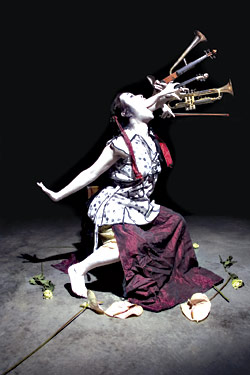Performances of the year, in no particular order: (1) Lynn Harrell’s turn as the cello personification of the title role in Richard Strauss’ Don Quixote with the Seattle Symphony. Opera singers could take lessons in emotional eloquence listening to Harrell bring this character to life without words. (2) Pacific Rims’ romp through John Cage’s three ebullient and earthy Constructions for percussion quartet. (3) Mark Salman’s performance of Liszt’s thunder-and-lighting, all-but-unplayable transcription of Beethoven’s Seventh Symphony, chosen to close his eight-concert traversal of Liszt’s piano works. He roared through the finale sounding like he had, oh, six or seven hands with a dozen fingers each.
Best revival: Sadly overlooked in Gerard Schwarz’s enthusiasm for American music is Virgil Thomson, but the SSO’s “Made in America” festival last spring redressed the neglect with the composer’s Symphony No. 2—a work premiered, as it happens, right here in Seattle in 1941. Damn, but it’s a weird piece, willfully banal and disjunct; it left the normally new-music-tolerant SSO audience exuding a palpable puzzlement. Runner-up: Daniel Catan’s luscious, intoxicating Florencia in the Amazons, beneficiary of Seattle Opera’s affectionate nurturance last February and at its 1998 local premiere.
Best new work: Of the several dozen new pieces I’ve heard this past year, one that continues to haunt me is Gerard Schwarz’s In Memoriam for solo cello (played during last May’s Music of Remembrance concert by his son Julian) and string quartet, written in memory of SSO cellist David Tonkonogui. Richly, moodily chromatic, brooding and intricate, Tonkonogui would have loved it.
Most heartening new-music audience response: (1) The word-of-mouth excitement and ticket demand for the Seattle Chamber Players’ performance of Piazzolla’s tango opera Maria de Buenos Aires—not only the scheduled performance but a Sunday morning dress rehearsal sold out; (2) The mob scene, with lines down the block, at the Moore Theatre before the Degenerate Art Ensemble’s all-orchestral concert.
Best photo: The DAE’s hallucinatory vision with dancer/composer/vocalist Haruko Nishimura. Why can’t all classical photos be this cool?
Best guests: Lesley “You Don’t Own Me” Gore and Judith “Miss Manners” Martin brought charm, sass, and wit to concerts by the Seattle Women’s Chorus and the Seattle Men’s Chorus, respectively.
Best new trend: Small-scale opera—some new, some old. In addition to their Piazzolla, the Seattle Chamber Players premiered Paul Dresher’s one-man The Tyrant, a tour de force for John Duykers. We also got Christian Asplund and Lara Candland’s Sunset With Pink Pastoral, Mozart’s Il re pastore, Jay Hamilton’s Blood, Barber’s A Hand of Bridge, and a half-dozen more to come in 2006. On top of all that grassroots activity, Seattle audiences were treated to three fully staged contemporary works—Florencia, Jake Heggie’s The End of the Affair, and Kirke Mechem’s Tartuffe—plus a Ring, for God’s sake. OK, I am officially no longer operatically envious of San Francisco.
Best reason to go to San Francisco, however: John Adams’ jaw-dropping Doctor Atomic, a taut and powerful meditation on Oppenheimer and the birth of the Bomb. Speight Jenkins was there opening night; rumor has it he loved it and is considering staging it here.
Gaffes of the year: (1) The cough that ricocheted like a gunshot through Benaroya Hall during the final melting note of “O mio babbino caro,” one of the encores on Renee Fleming’s January recital. Ever wonder what it’d be like to be instantly and simultaneously loathed by 2,500 people? (2) The cell phone that rang during Harrell’s Don Quixote (see above). Oops! It came from Harrell’s own pocket.







